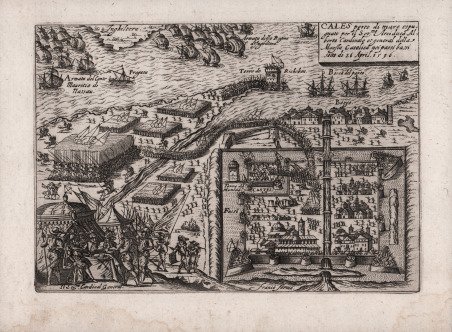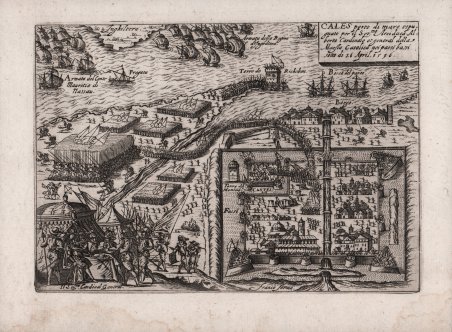Details
Description
Nel riquadro in alto a destra CALES porto di mare espu/gnato per il Sermo Arciduca Al/berto Cardinale et general della/ Maesta Catolica nei paesi bassi/ sotto di 26 April 1596 In basso a destra, nell’immagine: franco forma L’avvenimento raffigurato nell’incisione – la conquista del porto di Calais da parte degli spagnoli guidati dall’Arciduca Alberto d’Austria – rientra tra gli antecedenti che portarono al vittorioso assedio della città di Hulst (attuali Paesi Bassi), combattuto dalla metà di luglio al 18 agosto 1596, nell'ambito della guerra degli ottant'anni. Calais – che dal 1558 era sotto i Francesi - fu restituita a Enrico IV col trattato di Vervins, nel 1598. ' In basso sulla sinistra, fuori dalla sua tenda è raffigurato il generale Alberto d’Asburgo (1559 – 1621), intorno a un tavolo, intento verosimilmente a discutere con i suoi sottoposti. Sul tavolo si osserva il cappello cardinalizio: all'età di diciassette anni, il 3 marzo 1577, papa Gregorio XIII lo nominò cardinale del titolo di Santa Croce in Gerusalemme ex peculiari gratia. Alla morte del fratello maggiore Ernesto, governatore dei Paesi Bassi spagnoli, Filippo II nominò Alberto al suo posto: l'arciduca partì da Barcellona il 28 agosto del 1595 e prese possesso delle dieci province cattoliche delle Diciassette Province l'11 febbraio 1596. Seppur riluttante, il 31 luglio 1598 rinunciò al cardinalato e agli altri benefici ecclesiastici per sposare sua cugina, l'infanta Isabella Clara Eugenia, figlia di Filippo II: il matrimonio venne celebrato per procura a Ferrara da papa Clemente VIII il 17 dicembre 1598. Alberto assunse così la carica di principe sovrano dei Paesi Bassi meridionali con i titoli di duca di Brabante, Limburgo, Lussemburgo e Gheldria, Conte delle Fiandre, di Artois, Borgogna, Hainaut e Namur. In the cartouche at top right CALES porto di mare espu/gnato per il Sermo Arciduca Al/berto Cardinale et general della/ Maesta Catolica nei paesi bassi/ sotto di 26 April 1596 Bottom right, in the image: franco forma The plate depicts the siege of Calais of 1596 that took place between 8 April and 24 April 1596, as part of the Franco-Spanish War (1595-1598), in the context of the French Wars of Religion, the Anglo-Spanish War (1585–1604), and the Eighty Years' War. The city fell into Spanish hands after a short siege by the Spanish forces commanded by Albert VII, Archduke of Austria and Governor-General of the Spanish Netherlands. Subject then to the Spanish during 2 years, Calais didn't become French again until 2 years later at the treaty of Vervins. ' Below on the left, outside his tent is depicted General Albert of Habsburg (1559 - 1621), around a table, probably intent on discussing with his subordinates. On the table there’s the cardinal's hat: at the age of seventeen, on March 3, 1577, Pope Gregory XIII appointed him cardinal of the title of Santa Croce in Gerusalemme ex peculiari gratia. ' After the death of his elder brother, Ernst, governor of the Netherlands, in February 1595, he was appointed governor-general by Philip and given the task of subduing the rebellious Protestants in the seven United Provinces of the north. At Philip’s insistence, Albert reluctantly obtained a papal release from holy orders and dispensation to marry Philip’s daughter, the infanta Isabel. He received joint sovereignty of the Low Countries in 1598 as dowry for his marriage (April 1599) to Isabel. Cfr.


Find out how to use
Find out how to use

